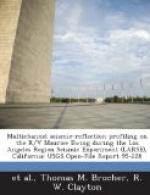|
This section contains 308 words (approx. 2 pages at 300 words per page) |
World of Scientific Discovery on William Maurice Ewing
Maurice "Doc" Ewing was born in Lockney, Texas, in 1906 and received his undergraduate and doctoral degrees from Rice Institute (now Rice University) in Houston. He spent most of his professional years teaching at Pittsburgh, Lehigh, and Columbia Universities. During this time, he undertook many ocean-mapping expeditions and expanded on the theories and work of Harry Hammond Hess, and Alfred Lothar Wegener, who introduced such concepts as seafloor spreading and continental drift.
Beginning in 1935, he applied both his geology and physics expertise to oceanographic study. He launched an exploration mission, funded by a grant from the Geological Society of America, which led him to study the structure of the continental shelf off the East Coast of the United States. Ewing's work was furthered by his construction, with the help of some of his students, of ocean-bottom cameras and devices for making seismic refraction measurements within deep ocean basins.
During World War II he was instrumental in developing and applying underwater photography and sound for use by the Navy. After the war, Ewing continued to lead expeditions with the intention of mapping crucial parts of the seafloor. His ultimate goal was to measure and study the characteristics of the mid-ocean ridges and rifts, in this case, the Mid-Atlantic Ridge. This mapping project was made possible by the development of sonar, ultrasonics, and a number of other newer technologies. By 1956, Ewing determined that the Mid-Atlantic Ridge spanned some 40,000 miles (64,000 km) of ocean floor.
Within two years, with the assistance of Marie Tharp and Bruce Heezen (1924-1977), Ewing also developed the Heezen-Ewing theory, which holds that an enormous central rift, at various points twice the size of the Grand Canyon, exists along the ridge and may be subject to underwater earthquakes. This discovery drew the interest of other scientists, who investigated the existence of other rifts in the ocean ridges.
|
This section contains 308 words (approx. 2 pages at 300 words per page) |


